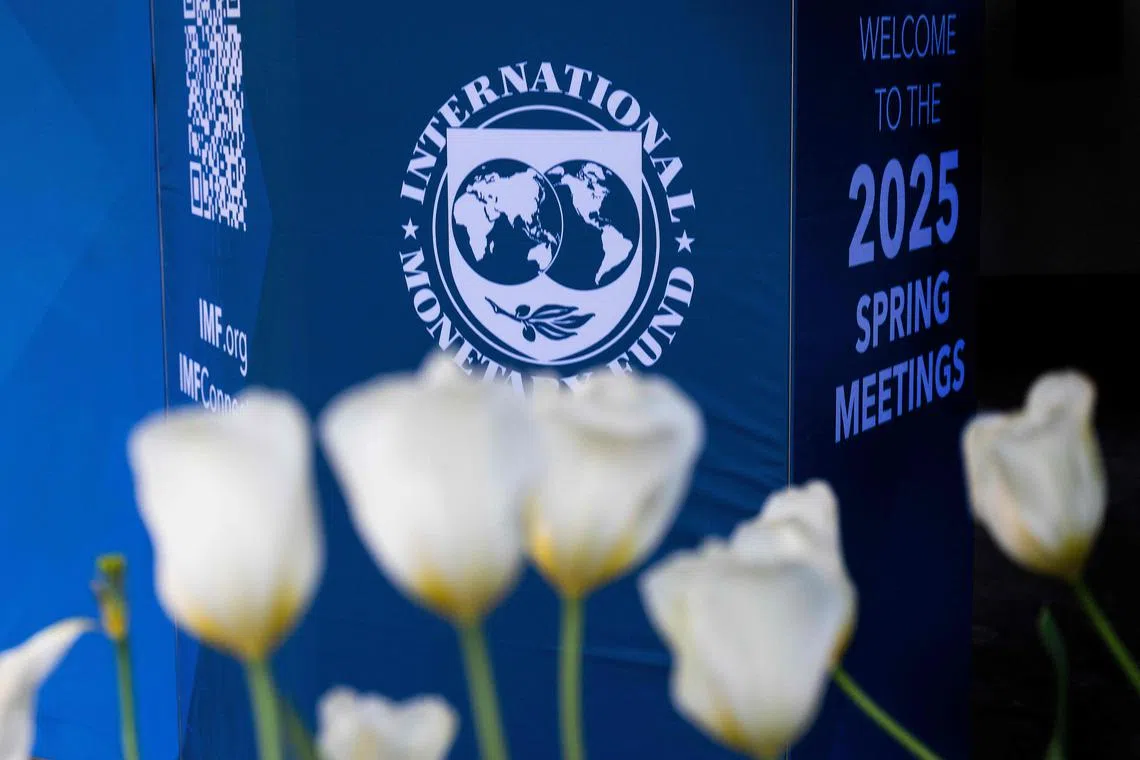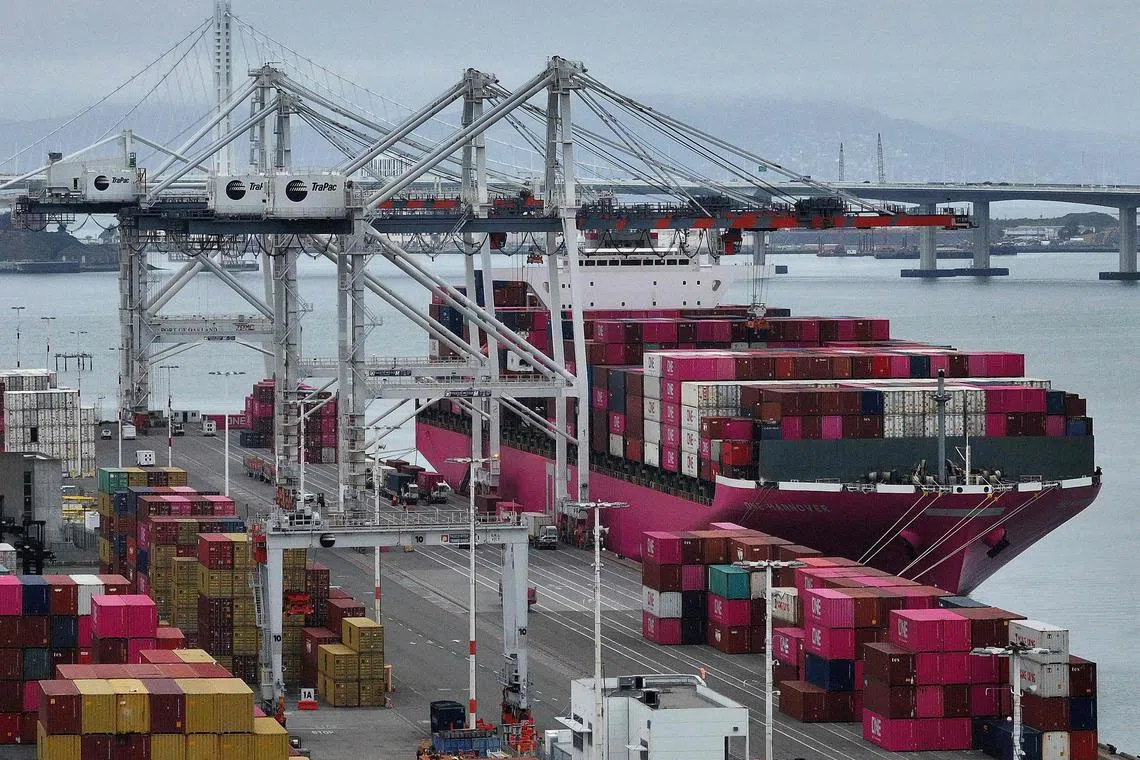IMF slashes global growth forecast, says downside risks dominate as Trump tariffs spark trade war
Sign up now: Get ST's newsletters delivered to your inbox

The IMF cut its projection for global output growth in 2025 to 2.8 per cent in its updated World Economic Outlook released on April 22.
PHOTO: AFP
Follow topic:
WASHINGTON – The International Monetary Fund (IMF) sharply lowered its forecasts for world growth for 2025 and 2026, warning the outlook could deteriorate further as US President Donald Trump’s tariffs spark a global trade war
The downgrades add weight to similar warnings from several Wall Street banks in recent weeks, with JPMorgan and Goldman Sachs saying the chances of a recession in the US have spiked.
The IMF cut its projection for global output growth in 2025 to 2.8 per cent in its updated World Economic Outlook released on April 22.
That was lower than its January forecast of 3.3 per cent and would be the slowest expansion of gross domestic product since the Covid-19 pandemic in 2020.
It would also be the second-worst figure since 2009.
The fund reduced its estimate for 2026 to 3 per cent, a drop of 0.3 percentage point.
For the US, the trade war will stoke a supply shock that drives up prices and weighs on productivity.
For trading partners, the higher duties will translate as a demand shock that hits output and prices.
Effective tariff rates in the US have jumped to levels not seen in a century, the IMF said.
“We are entering a new era,” IMF chief economist Pierre-Olivier Gourinchas said in a briefing with reporters. “The global economic system that has operated for the last 80 years is being reset.”
US stocks, the dollar and long-dated Treasuries have been volatile amid the Trump onslaught, sinking on April 21
The S&P 500 Index has lost around 12 per cent since the end of 2024.
The US and China were among countries to see the biggest IMF downgrades.
The US is forecast to grow 1.8 per cent in 2025 and 1.7 per cent in 2026, a cut of 0.9 and 0.4 percentage point, respectively.
The IMF increased its forecast for US inflation in 2025 by roughly 1 percentage point to 3 per cent.
China is tipped to grow 4 per cent in 2025 and in 2026, down by 0.6 and 0.5 percentage point.

China’s economy is tipped to slide by 0.6 percentage point in 2025 due to a trade row between Washington and Beijing.
PHOTO: AFP
Pain all around
Top US trading partners Mexico and Canada are both predicted to be negatively impacted by the Trump tariffs.
The Mexican economy is now projected to contract by 0.3 per cent in 2025, a 1.7 percentage-point reduction from January, while Canada’s growth outlook has also been sharply reduced.
Japan, the world’s third-largest economy, is expected to grow by just 0.6 per cent in 2025 and 2026, a sharp cut from January.
The IMF expects the tariffs to act as a drag on growth in most European countries, with the growth outlook for the euro area cut to 0.8 per cent in 2025 and 1.2 per cent in 2026.
Germany is now projected to see no growth in 2025, while the outlook for France, Britain and Italy has also been pared back.
The IMF sharply downgraded the outlook for the Middle East but still expects economic activity to pick up from 2024, as disruptions to oil production and shipping ease, “and the impact of ongoing conflicts lessens”.
In sub-Saharan Africa, growth is projected to decline slightly to 3.8 per cent in 2025 before recovering in 2026.
Further escalation
The world’s growth prospects would improve immediately if trade tensions calmed and longstanding complaints about non-tariff barriers and trade-distorting measures by some countries were addressed, the IMF said.
Still, it said the near-term risk is of further escalation with knock-on consequences for growth.
The Washington-based fund cut its forecast for global trade growth in 2025 by 1.5 percentage points and sees only a slight recovery in 2026.
“The risks to the global economy have increased and are firmly to the downside,” Mr Gourinchas said.
The IMF cautioned that many scenarios are possible, given the uncertainty surrounding trade policy.
It said it jettisoned projections that had been nearly finalised before April 2, when Mr Trump announced sweeping tariffs on the world, and was forced to compress a forecasting cycle that typically takes over two months into 10 days.
In an explainer of how it compiled its new forecasts amid the rolling tariff turmoil, the IMF said it has used a reference forecast – or a central scenario – based on information available as at April 4, rather than a baseline forecast.
Bloomberg Economics analysts Alex Isakov and Adriana Dupita last week found that, based on a review of previous IMF forecasts, the fund tends to underestimate the depth of downturns.
“The IMF’s projections tend to skew optimistic during potentially disruptive crises,” they wrote. “However much the IMF may downgrade the growth forecasts to start, history suggests the ultimate blow will be worse.” BLOOMBERG, AFP

